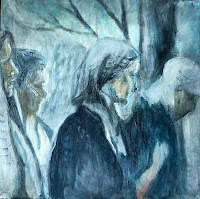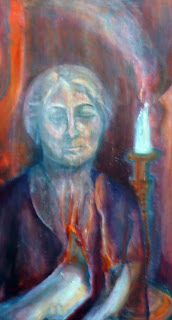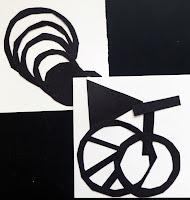Last week we discussed synesthesia. The word literally translates from Greek to mean “together sensation”. It is when one sense stimulates another such as seeing colors when one hears music. Our starting point had been a passage in Exodus that talks of seeing sound. At the most recent session we picked up with that passage yet again and our facilitator noted that when she translated the Hebrew it first speaks in present tense and then shifts to past tense. So the true passage reads “the entire people see the thunder and the flames, the sound of the shofar and the smoking mountain; the people stood and trembled and stood from afar”.
In discussing its meaning we talked about collapsing time with all periods existing simultaneously, especially when thinking of time in the realm of the sacred. We are to read such passages as if we too were present at Mt. Sinai, even though we stand from afar. Ritual is an important element in compressing time as it links us to the past. The question was posed as to whether we addressed or considered time in our artwork.

Now I never had pondered this question before, but anyone painting around the issue of family history and legacy has to address time in some fashion. I did a series titled "A Hole in Time" which was looking back in time through imagery that resembled a pinhole camera with muted colors and a darkened edge, just a little bit of light emitted to allow us to see and imagine the past.
In my recent painting “From Her Mother”, I represented time in
 overlapping circles meant to represent generations sitting down around the same table, linked through rituals that have been handed down, literally through time. Objects and artifacts survive even as the people who used them pass on. I imagine those artifacts being passed through those circles of time, representing the rituals in which their users engaged, rituals that we may now share and continue, linking us back.
overlapping circles meant to represent generations sitting down around the same table, linked through rituals that have been handed down, literally through time. Objects and artifacts survive even as the people who used them pass on. I imagine those artifacts being passed through those circles of time, representing the rituals in which their users engaged, rituals that we may now share and continue, linking us back.
Our discussion shifted to the idea of ritual as a marker of time. Lighting the Sabbath candles delineates the beginning of the Sabbath. The Havdalah ceremony marks the end. I thought of my painting "Fire, Light and Legacy" with its 200 year old candlesticks handed down through generations and used for the blessing of the Sabbath candles. Questions were posed. What rituals do you observe? What time periods do they mark?
Before I begin a painting there are little rituals I engage in to settle into it. For my current series that is based on interviews, I first marinate in story, rereading interviews to put myself back into the story. Then I see what imagery bubbles to the top. I may also research some aspect of the story. Only then do I paint, first building a ground by laying down color while I listen to my favorite painting music, a CD of Sephardic music I found in Cordoba, Spain. I conclude my painting by cleaning brushes, then setting my painting across the room where I can study it and contemplate next steps.
We then turned to the B'rakhot, the blessings of gratitude in Judaism which are also a ritual of sorts. Many of these blessings are around the wonders of nature. One says them when one hears thunder, sees a rainbow or sees trees in bloom for the first time in the year. Even one for when we wear new clothes. Part of the purpose of the blessing is to heighten awareness, not a mindless ritual, but a mindful one. To see through fresh eyes. To recognize and affirm gratitude for life's wonders.
The process of artwork can also contemplate time. When I saw the recent Matisse show at the Metropolitan, they showed a series of photographs of Matisse's work in process and its evolution. I take photos as I work also and it is fascinating to look back at the evolution of a painting which I would soon forget without that photographic reminder. It reaffirms for me that a painting can change in ways I can’t always imagine initially. As can life. It is a process that unfolds. Each step building on those that came before.
 Our exercise for the evening was to cut geometric shapes from black paper and create time constructions on white paper. I created the shofar-like shape that I had formed in my painting "From Her Mother" of layers of connected tables as well as the suggestion of a bicycle-like vehicle moving backwards through time, my own personal time machine with a big horn to sound or perhaps "see" the way. With a roomful of artists we had many creative approaches and thought processes, often veering into 3-D constructions.
Our exercise for the evening was to cut geometric shapes from black paper and create time constructions on white paper. I created the shofar-like shape that I had formed in my painting "From Her Mother" of layers of connected tables as well as the suggestion of a bicycle-like vehicle moving backwards through time, my own personal time machine with a big horn to sound or perhaps "see" the way. With a roomful of artists we had many creative approaches and thought processes, often veering into 3-D constructions. *The Jewish Artists’ Laboratory is an arts initiative through the Sabes Jewish Community Center featuring 17 artists exploring the theme of Text/Context/Subtext through study and art making. The project is funded through The Covenant Foundation and similar projects are being done in both Milwaukee and Madison. Artists explore how the theme of Text/Context/Subtext is relevant to Jews and non-Jews, to religious and non-religious, to the community and to the individual, to the artist and the non-artist.





No comments:
Post a Comment